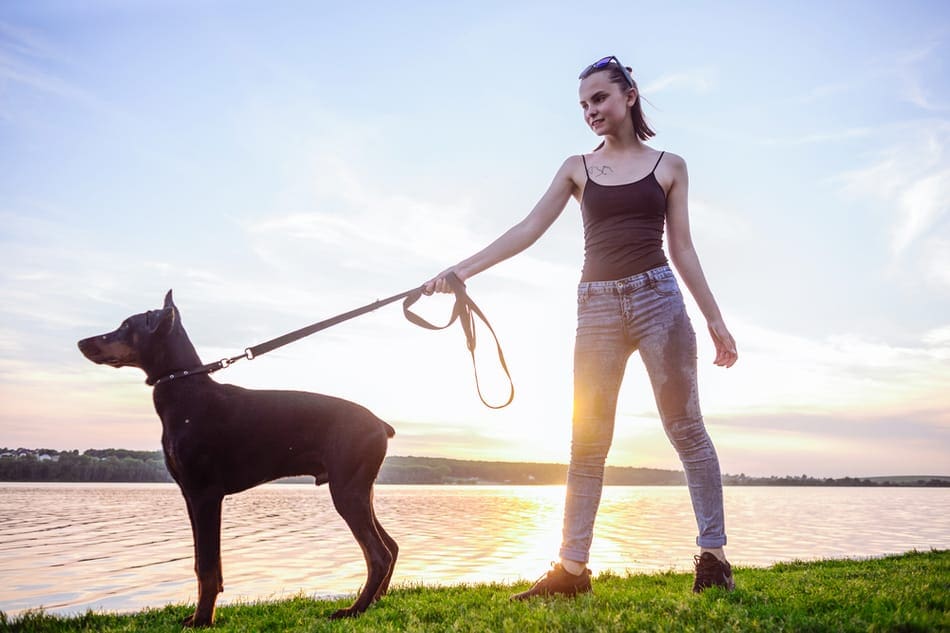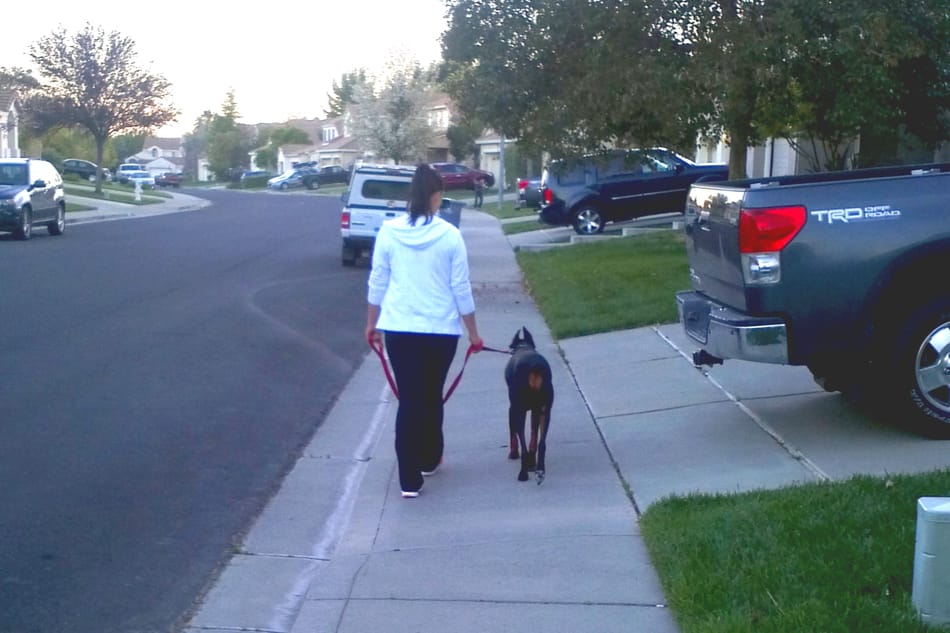
Probably one of the best things you can do for yourself and your Doberman is to have your Doberman leash trained. It may not always be easy, but accomplishing this will allow you to go on walks together without the stress and strain of constant leash pulling. Dobermans need lots of exercise and having your dog leash trained will make getting that exercise much easier.
How do you train a Doberman to heel? Training a Doberman to heel while walking on a leash can be done through consistent reward-based practice inside the home and later graduating to practicing in public areas with more distractions.
Here’s the problem; Dobermans can be a little headstrong. So you need to know how to teach leash training in a way that works specifically well for Dobermans. These dogs naturally want to be alpha dogs. They want to walk in front of you and take control. They’re also large and strong so sometimes it feels impossible to get a Doberman leash trained.
It’s because they’re so large and strong however that leash training them is so important. Not just to reduce your stress, but for safety reasons. Over my time working with Dobermans, this is the method that I found to be most effective and it works by playing off their natural instincts.
Before You Start
There are a few things that you should have in order before you begin leash training your Doberman. Don’t skip any of these because the head-strong Doberman can be incredibly stubborn with leash training, so you need to start off correctly.
- Practice basic manners. Instilling minimal manners in your dog will work wonders for leash training. A great, simple way to do this is to make sure you’re always the first through a door. If your dog is in the habit of waiting for you to go through a door before you allow them through, it’ll help establish yourself as the one in charge and your dog will develop some basic self-control.
- Teach your dog the “sit” command. This is a necessary command that we will use during the step-by-step leash training guide below.
- Teach your dog a release command. This is another necessary command that your dog needs to know for this process to work. This is any command that tells your dog that he’s done with what you asked of him and he can relax. For my Doberman, the command was “Ok!” but many prefer using other words since ok is used so frequently in daily speech. Words like “free”, “finish”, “all done”, or “all clear” work great.
- Have a non-extendible leash and a standard collar. Extendable (or retractable) leashes won’t work since they teach your dog that to have more freedom he only needs to pull harder. So have a good regular leash on hand—I prefer a standard 6-foot leash. Pronged or choke collars aren’t appropriate when you’re first starting, so go with a basic collar. We’ll talk about using pronged collars in a bit.
- Have dog treats for a reward. This is very important since the leash training will be reward and praise based. This will be your dog’s reward. For best results, have a treat that he goes crazy over but isn’t given to him at any other time—only while leash training. This will keep it exciting for him. I suggest specific treats for training purposes on my recommended food and treats page here.
- Decide on a reward marker. Every time you want to reward your dog throughout this training, you need a reward marker. You can buy a dog training clicker or you can simply decide on a verbal cue for this like “good boy!” This is what you’ll do anytime the instructions below say to “praise” your dog.
Once you have these things in order, you can move on to the step-by-step guide below to start leash training. If you have all six of these things squared away, you’ll in about as good as spot as possible to succeed with leash training!
TIP:
There are some subtle differences between how male and female Dobermans learn new training concepts. To dive more indepth into this, look at my article Male vs. Female Doberman: Which is Better?

Doberman Leash Training: Step-by-Step
As you follow these steps, remember not to graduate to the next step until you believe your dog has a solid understanding of the step you’re currently on. This can take a lot of patience for a headstrong alpha dog like a Doberman. Just be prepared, consistent, and patient!
Step 1 – Teach Your Dog to Yield to Leash Pressure
This is pretty basic and all you need to do is familiarize him with this concept—he doesn’t need to master it. You want him to understand that light pressure from the leash means he needs to go that direction. Practice this someplace where there will be little to no distractions. Inside your home or in a fenced yard usually works very well for this.
- Start with your Doberman at your side, lower the lead (or leash) until it’s parallel to the ground and apply a small amount of pressure to his lead to one side so he moves towards the direction of the pressure. As soon as he does, immediately praise and reward your dog. Then bring him back to your side.
- Continue doing this in different directions until you notice he is willingly going the direction in which you apply light pressure consistently. You want him focused on you and looking for that reward when he does what you want. Your dog now understands the basics of yielding to leash pressure!
Step 2 – Practice the Heel Position
The next step is to practice the heel position. Also, do this step in a place where there’s little or no distractions. Lead him to your side so his front feet are in line with your feet—this is the “heel” position.
- Once in that position, use your reward marker (dog clicker or verbal praise) and give a treat. Make sure he notices that you have the treats so he is better able to focus on you.
- Continue rewarding him as he sits there, one reward and praise every few seconds.
- After about 10-20 seconds, depending on how long your dog is able to do this, give another big praise and reward, then give him the release command.
- Now allow him to sniff a few things and “be a dog” for a minute. Do not allow him to pull during this time. If he pulls, stop, and back up a few steps.
- Now repeat these steps—each time increasing the length of time you keep him at your side and the length of time between each reward and praise. Use the treat in your hand as a way to keep his attention.
Step 3 – Start Walking Short Distances
Now that you have his attention and he is starting to understand that he is rewarded for being in the heel position (at your side) it’s time to walk.
- With his focus either on you or your hand which has the treat, start walking a few steps with him at your side. Walk 10 to 15 feet, then stop, give the sit command, reward, and praise. Your hand in front of his nose with the treat in it should help keep his focus while also preventing him from walking out in front of you.
- Only praise and reward your Doberman once you stop and he sits down as you command him to. If he doesn’t, apply light upward pressure on the leash while giving the sit command to encourage him to sit down. Once he does, release the upward pressure, praise, and reward.
- Do not walk unless the dog is at your side and giving you slack on the leash. If he starts to walk in front of you, stop and back up a few steps then tell him to sit again. Do not wait until he is pulling on the leash to correct him, correct him as soon as he tries to leave your side and walk in front of you.
- Give the release command after a short time of doing this and allow him about a minute to sniff around and be a normal dog (still on the leash, and with you still not allowing him to pull you). As you progress with this, there should be longer periods of time between his breaks, but you should never stop giving breaks entirely.
Step 4 – Repeat and Correct as Necessary
Repeat these steps while applying corrections as necessary along the way. This is where most people give up and fail at leash training. With a headstrong dog like a Doberman, you may have to do this many times until he “gives up control” of the walk. But it’s imperative you stick with this and are incredibly consistent. It will slowly get easier with practice, I promise.
- As you practice, remember that your dog should be in the habit of always sitting when you come to a stop. If he doesn’t, give the sit command in a firm voice with a little upward pressure on the lead. Once he sits, praise and reward.
- You will also need to correct your dog if he becomes distracted. Learning to ignore distractions in the environment is part of his training.
- Begin practicing 180 degree turns by guiding him as your turn. Immediately reward him if he turns smoothly while maintaining the heel position next to you, or better yet, he anticipates your turn.
Step 5 – Gradually Transition to Public Places
Just like with any of these steps, don’t progress to this step unless he has shown that he has the other steps down. Now that he is demonstrating a solid understanding of the concepts, it’s time to take him to someplace with more distractions.
- Bring him to a park or other public setting with people within eyesight, but still somewhat in the distance.
- Continue practicing these concepts while working hard to make sure he maintains his focus on you. If he gets distracted, stop and back up a few steps, then have him sit.
- As he demonstrates that he can maintain focus even with distractions, start walking closer to people or other distractions that are present. Continue this until he demonstrates proficiency in walking on the leash in the heel position even in the face of distractions.
The American Kennel Club (or AKC) has a section on its website all about leash training a dog here. It’s not incredibly detailed but if you want some more pointers to supplement what you learned here, it could be worth taking a look.
Stop Training Him to Pull on the Leash
Unfortunately, it’s far too easy to reinforce bad behavior when he’s on a leash. You may be actually training him to pull on the leash without even knowing it. Whenever your dog pulls on the leash, if you walk with him and let him lead you over to whatever he wants to sniff—then you just reinforced leash pulling.
Any time your dog tries to pull you a certain direction you need to stop, walk a few steps back while guiding him backward, then tell him to sit. This will make pulling on the leash not any fun for him. When it’s not fun, he won’t want to do it.
Reasons Most People Fail
There are some common reasons that most people fail when it comes to leash training their Doberman. Hopefully knowing these reasons will help you avoid some of the common mistakes.
The first, and biggest reason most people fail at this is a lack of consistency. They’ll practice leash training for a day or two, but then they’ll want to take him on a real fast walk someplace. They’ll tell themselves that they can’t take all day on this one specific walk so they’ll let the dog lead, get distracted, or pull the leash. One day of this can set you back weeks of leash training.
You need to practice these steps with your Doberman, very consistently, and sometimes for months before he’ll understand and react appropriately. Starting leash training is a big commitment and you need to see it through or it will be very difficult correcting things later.
TIP:
Your leash training session shouldn’t be your dog’s first exercise of the day. Your Doberman will have too much energy, especially if they’re young. Exercise your dog beforehand so he’ll have an easier time focusing.
Your dog needs to know that walking on the leash will always be the same and with the same expectations from you—with NO EXCEPTIONS. Dobermans are incredibly intelligent and if they think that you just decide in the first few minutes of a walk whether there will be rules during this walk, then they’ll do everything they can to convince you that it’s not worth making this walk one of the “strict ones”. Usually by being as much of a pain as possible.
The second reason people often fail at this is that they don’t give their dogs the release command and allow them to sniff around in their environment enough. Giving him breaks is very important. They still need to be a dog from time to time and if they know you’ll still allow this on occasion, they will be much more willing to put in the effort to behave when you need them to.
Using Pronged Collars
Choke collars, or prong collars, are somewhat controversial since many people see them as cruel. Here’s the thing, they are great training tools if used correctly—but yes, they’re somewhat cruel if they aren’t.
The biggest issue is that people will start using pronged collars on their Doberman before he’s leash trained. This is where it becomes cruel. If your dog still hasn’t figured out what is expected of him, he could hurt himself while he’s still figuring it out.
Pronged collars should really only be used later in leash training when your dog already has a basic understanding of what’s expected of him. If used in this way, they are very safe, humane, and a great training tool to reinforce what your dog already knows.
Also, you should never use one on a dog younger than 6 months of age, but to be safe, I’d even go further and say one year or younger. If you do decide someday to incorporate a pronged collar, use small corrections only and never apply prolonged pressure from the dog’s lead.
Final Thoughts
Leash training is probably among the most important things you can do for your Doberman (and yourself). It’s no secret that Dobermans need a lot of exercise, and if you don’t have an easy and efficient way of taking your dog outside for that daily exercise, then you’ll be less likely to do it.
This can lead to increased anxiety in your dog and destructive behavior. Trust me, that will only lead to increased anxiety for you. Listen, I know from personal experience—leash training can be very trying and take a whole lot of patience, but having a leash trained Dobie is such a major stress reliever. Stick with it, be consistent, and you’ll thank yourself later.
Related Questions
How long should you walk a Doberman? Young or elderly Dobermans, or those who are out of shape, should walk about 15 to 45 minutes at a time. Healthy, adult dogs in optimal shape can easily walk 2 hours or more. Dobermans need a total of about 1 to 2 hours of exercise per day.
Other Resources
- How to Train a Doberman: The Complete Guide – This is Doberman Planet’s complete guide on how to train a Doberman for obedience and behavior.
- How to Get a Doberman Puppy to Stop Biting: The Best Method – A puppy who’s biting or nipping too much is probably the other most common issue Doberman owners have. Here’s the best method I’ve found for dealing with this.


